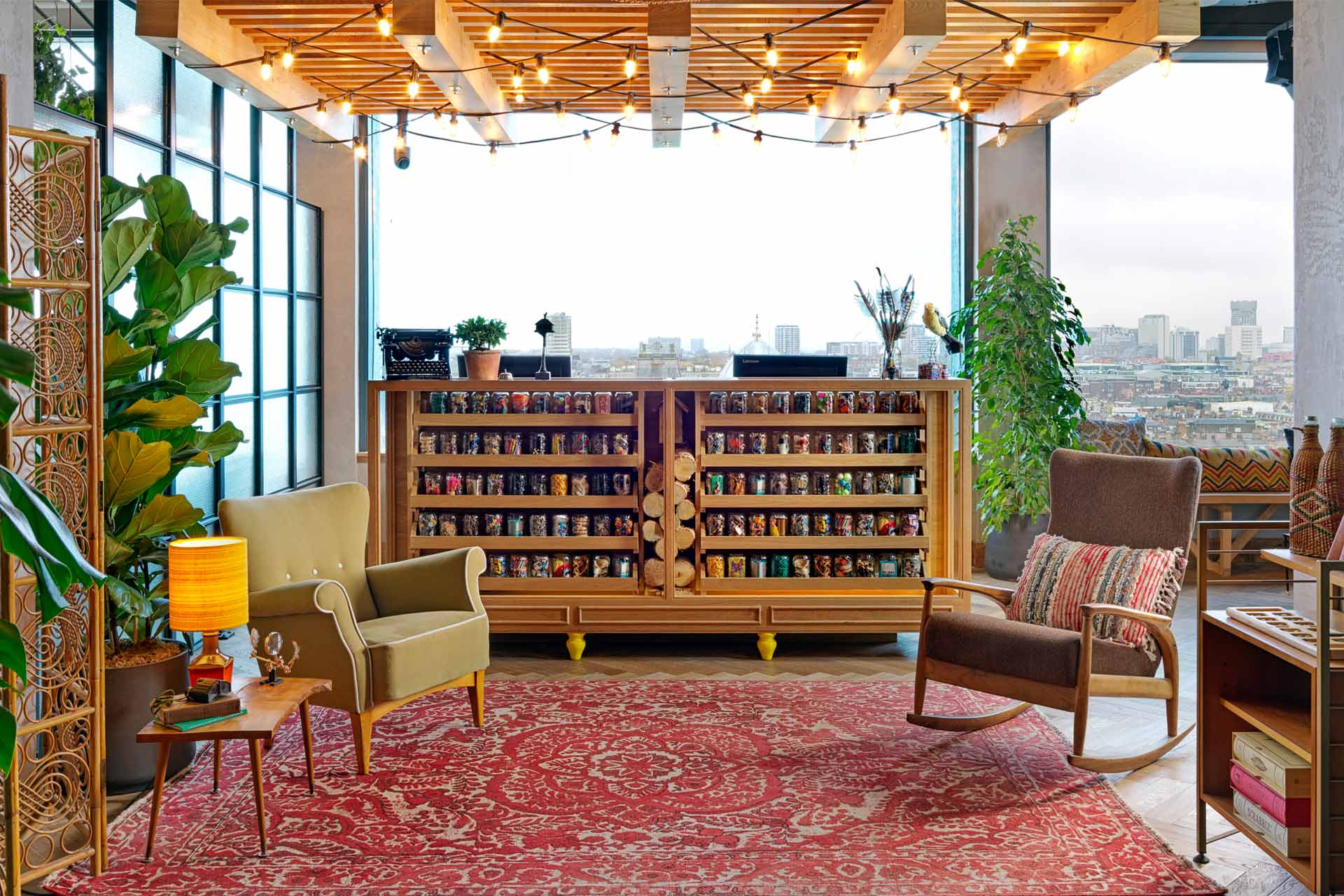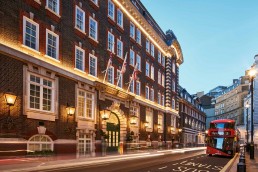The debut hotel from Barry Sternlicht’s new Treehouse brand swings through the treetops with playful, nostalgic glee.
When we think of treehouses, there’s a tendency to lean towards childhood adventure and summer holidays, but the history of treetop accommodation goes back much further. There is evidence to suggest that we inherited the idea from prehistoric ancestors who sought shelter in the canopy by instinct, safe up high from the predators and harsh conditions below.
Even today, tribes like the Korowai of West Papua raise structures in treetops to protect supplies from scavenging animals, as do many indigenous riverside communities at risk from flooding. But whilst most 21st century treehouses may have lost their important role in the survival of the species, they haven’t lost their charm.
Thanks to a mix of nostalgia and novelty, recent years have seen their resurgence in the hotel market. Elaborate structures have sprung up from Mexico to Thailand, welcoming those who enjoy the idea of spending a night in their childhood treehouse but not so much the cold reality, whilst projects like Treehotel in Swedish Lapland – a series of high-design takes on the concept by architects including Sandell Sandberg and Tham & Vidgård – have raised their profile and marked the branches as prime real estate.

Despite their popularity, however, projects in this vein have been limited to rural spaces, unable to tap into larger urban markets where suitable tree options are sparse. Until now the question remained: can you build a treehouse without a tree?
Whilst it might not look like one from outside, and most trees surrounding it were paved over long ago, the new Treehouse Hotel from Barry Sternlicht’s SH Group might have the answer. To the casual observer, the converted office block overlooking London’s Broadcasting House could seem just another functional hangover from the 1970s, but through its doors, the name runs deep in both narrative and execution.
“As a team, we studied classic treehouse structures and tried to capture the essence of being in a treehouse without physically recreating one,” explain SH Group’s in-house design team. “We wanted to tap into the emotional connection to that private place one had as a kid, with no adults allowed and a special knock on the door to enter. It’s that simple imagination translated into design.”
Beginning with street-level café The Backyard – a brief space with wood panelling and climbing branches as early thematic signifiers – a row of elevators running the corridor behind take guests up to the hotel proper. Guestrooms start around halfway up, whilst the lobby tops the project. Viewed as blueprint, this inverted layout would not look dissimilar to root, trunk and crown.

A lengthy window overlooking an impressive spread of London skyline runs behind the reclaimed check-in desk, where guests are introduced to the brand’s nostalgic themes by way of jars stacked neatly with trinkets like Lego, crayons and toys. Along with ideas of childhood, adventure, independence and an undercurrent of sustainability, nostalgia is a guiding force throughout the scheme, whether that’s the vintage rocking chairs that flank the desk, to the Paddington Bear teddies, cuckoo clocks and curated postcards that detail guestrooms. Warm shades of mustard and maroon are softly lit by canopy lights recalling fireflies, whilst wooden accents in herringbone floors and carved screens are punctuated by tall potted plants and a living green wall.
“Nostalgia is important, but only if it has real meaning,” say the team. “We also aimed to meld both American and British cultural references and were not bashful when going about this. We layered items that seemingly had no business being placed together, then finessed them until they felt right. For example, a mashup of periods and styles – mid-century modern paired with colonial Windsor and Victorian, and 1970s and ‘80s popular culture with nostalgia. It’s a look of being accidental, but intentional.”
Guestrooms ranging from the 258ft2 Fort and Lookout options to the Studio and Clubhouse Suites – 395ft2 and 431ft2 respectively – emphasise these pillars through a combination of homely features drawn from the treehouse, and industrial elements inspired by the views. Exposed concrete ceilings are balanced by recycled wooden floors and frames – as well as lengthy sections of tree branch in bathrooms– while black metal screens and brass touches are softened with mid-century frosted glass globes. Almost all rooms have a large window with a seating perch – a small design touch that goes a long way in creating the nostalgic effect. It’s an approach that can be observed throughout, with the scheme walking a delicate line between playful kitsch and sentiment.
Amidst the branches is Madera – a sister restaurant to LA’s Toca Madera – serving elevated Mexican fare (by way of California) with a focus on organic ingredients. Accessed from the lobby via a tunnel of curving, sculpted planks, the space is defined by forest-esque interiors that see plant life hanging from rafters and climbing panelled columns. Wooden basket lanterns hang above, through which light shines as it might through leaves, and wicker chairs cushioned with vibrantly patterned fabrics add pops of wildlife colour. Throughout the day, Madera is light and airy, but darkens at night for a more sophisticated scene – the wraparound floor-to-ceiling windows dotted with the city lights beyond. Rounding out the F&B programme are several private hollows that carry the rustic styling, as well as The Nest, where a stone bar sits atop stacked wooden blocks, and an outdoor terrace is clad in another living wall.

The greenery throughout the hotel isn’t just for show, however. Despite being set over one of the busiest centres of urban activity, the tree hasn’t forgotten its roots. Underscored with sustainability throughout, green elements of the hotel’s design and operation aim to ensure that there will be enough trees left for future expansion, as well as guests to inhabit them. Composting and recycling programmes are complemented by organic cottons and locally manufactured bathroom amenities, whilst Madera’s focus on natural ingredients sees that even those just stopping for an hour’s dinner are playing their part.
“There was a conscious awareness in everything we designed and selected,” the studio offer. “We used predominantly natural and organic materials, low VOCs, smart building systems and most importantly, gave new life to found and repurposed objects. For example, the entrance of Treehouse has been clad in natural timber shingles, offering a contrast to the grey concrete cladding of the original building.”
Together, these threads of substance and style offer a compelling introduction to the brand. “Each location will tap into the local neighbourhood culture, but also pull from its experiences of being an international brand,” the team concludes. “No two will be alike, but you will know you’re in a Treehouse.”
Its next move may be firmly under wraps for the time being, but if it is able to maintain this level of dedication to the cause in similarly dense urban destinations, then we may look back on this debut as the beginnings of a forest. So, can you build a treehouse without a tree? It would certainly appear so.
EXPRESS CHECK-OUT
Owner: SH Group
Interior Design: SH Group
www.treehousehotels.com
CREDITS
Words: Kristofer Thomas
Photography: © Simon Brown
Magazine: Sleeper 90
Related Posts
7 April 2020
Feature: Ruby Lucy, London
27 March 2020
Feature: Great Scotland Yard, London
25 March 2020



